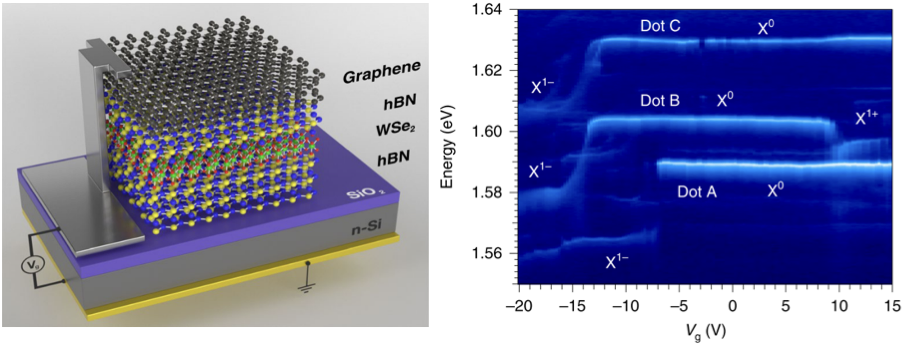Coulomb blockade in an atomically thin quantum dot
Gate-tunable quantum-mechanical tunneling of particles between a quantum confined state and a nearby Fermi reservoir of delocalized states has underpinned many advances in spintronics and solid-state quantum optics. The prototypical example is a semiconductor quantum dot separated from a gated contact by a tunnel barrier. This enables Coulomb blockade, the phenomenon whereby electrons or holes can be loaded one-by-one into a quantum dot. Depending on the tunnel-coupling strength, this capability facilitates single spin quantum bits or coherent many-body interactions between the confined spin and the Fermi reservoir. Van der Waals (vdW) heterostructures, in which a wide range of unique atomic layers can easily be combined, offer novel prospects to engineer coherent quantum confined spins, tunnel barriers down to the atomic limit
or a Fermi reservoir beyond the conventional flat density of states. However, gate-control of vdW nanostructures at the single particle level is needed to unlock their potential. Here we report Coulomb blockade in a vdW heterostructure consisting of a transition metal dichalcogenide quantum dot coupled to a graphene contact through an atomically thin hexagonal boron nitride (hBN) tunnel barrier. Thanks to a tunable Fermi reservoir, we can deterministically load either a single electron or a single hole into the quantum dot. We observe hybrid excitons, composed of localized quantum dot states and delocalized continuum states, arising from ultra-strong spin-conserving tunnel coupling through the atomically thin tunnel barrier. Probing the charged excitons in applied magnetic fields, we observe large gyromagnetic ratios (∼8). Our results establish a foundation for engineering next-generation devices to investigate either novel regimes of Kondo physics or isolated quantum bits in a vdW heterostructure platform.

